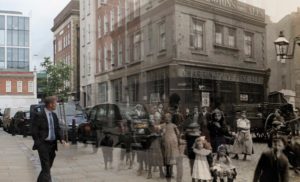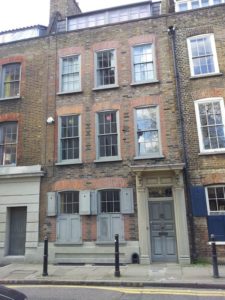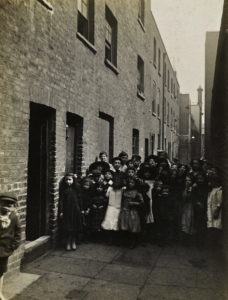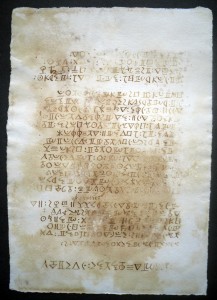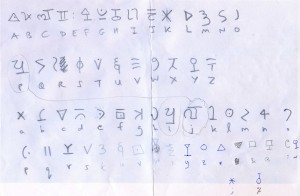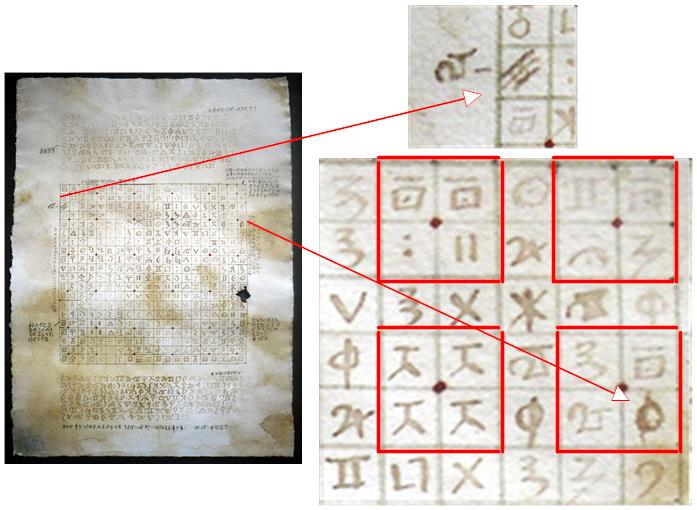The other day, I was wondering where in East London (according to the story the owner told me) the Blitz Ciphers were found: and also wondered if they might have been left behind by some kind of mathematical society.
As an aside, the problem with any speculative mathematical link to Freemasonry is that even though Masonic theoretical historians like to talk about (capital-G) Geometry and how the Great Architect of the Universe (errrrm: God, basically) is somehow ineffably mathematical, their rather grand Platonic-Christian narrative breaks down when you bother to look at the details. The short version is that if there is any genuine maths in Masonry beyond basic Euclid-for-Dummies, it seems to me to be extraordinarily well-hidden.
(As always, if you happen to know of specific examples of mathematical Masonic societies that run counter to this sweeping generalization, please feel free to leave a comment below.)
So I instead went looking for genuine historical mathematical societies in London’s East End: and was delighted to discover the all-too-brief splendour of the Spitalfields Mathematical Society.
The Spitalfields Mathematical Society, Crispin Street
Conspiracy theorists and armchair cold case amateur detectives know this part of London well: the Ten Bells pub just around the corner was frequented by Jack the Ripper’s victims, the last of whom was found in Millers Court (close to Crispin Street). (Pastry chef geezer Jamie Oliver’s great-great-grandfather was for a while the Ten Bells’ landlord, for all you TV trivia fans.)
Incidentally, I found a rather nice website that blends historical photos of Spitalfields (taken by C. A. Mathew around 1912) with modern photographs taken on the same spot, to give an eerily evocative effect (such as the following image of Crispin Street):
But long before even C. A. Mathew, the history of the area revolved around Huguenot weavers, whose houses in Fournier Street are still there:
And it was the Huguenot immigrants who the Spitalfields Mathematical Society was originally aimed at, according to most accounts. De Morgan’s (1872) “A Budget of Paradoxes” describes it thus:
Among the most remarkable proofs of the diffusion of speculation was the Mathematical Society, which flourished from 1717 to 1845. Its habitat was Spitalfields, and I think most of its existence was passed in Crispin Street. It was originally a plain society, belonging to the studious artisan. The members met for discussion once a week ; and I believe I am correct in saying that each man had his pipe, his pot, and his problem. One of their old rules was that, “If any member shall so far forget himself and the respect due to the Society as in the warmth of debate to threaten or offer personal violence to any other member, he shall be liable to immediate expulsion, or to pay such fine as the majority of the members present shall decide.” But their great rule, printed large on the back of the title page of their last book of regulations, was “By the constitution of the Society, it is the duty of every member, if he be asked any mathematical or philosophical question by another member, to instruct him in the plainest and easiest manner he is able.” We shall presently see that, in old time, the rule had a more homely form.
I have been told that De Moivre was a member of this Society. This I cannot verify : circumstances render it unlikely ; even though the French refugees clustered in Spitalfields ; many of them were of the Society, which there is some reason to think was founded by them. But Dollond, Thomas Simpson, Saunderson, Crossley, and others of known name, were certainly members. The Society gradually declined, and in 1845 was reduced to nineteen members. An arrangement was made by which sixteen of these members, who were not already in the Astronomical Society became Fellows without contribution, all the books and other property of the old Society being transferred to the new one. I was one of the committee which made the preliminary inquiries, and the reason of the decline was soon manifest. The only question which could arise was whether the members of the society of working men for this repute still continued were of that class of educated men who could associate with the Fellows of the Astronomical Society on terms agreeable to all parties. We found that the artisan element had been extinct for many years ; there was not a man but might, as to education, manners, and position, have become a Fellow in the usual way. The fact was that life in Spitalfields had become harder : and the weaver could only live from hand to mouth, and not up to the brain. The material of the old Society no longer existed.
London had a fair few broadly similar societies – the Mechanic’s Institution and the London Architectural Society to name but two – but if you were looking for a mathematical society in East London that had long disappeared and some of whose papers might -possibly- have been the Blitz Ciphers, the Spitalfields Mathematical Society would seem to be at the very least an interesting candidate, right?
But the immediate question is…
Was Crispin Street bombed in WWII?
Having once idly flicked through a copy of “The London County Council Bomb Damage Maps 1939-1945” hardback when it came out in 2015, I half-remembered that the London bomb maps were all at the London Metropolitan Archive, and had once upon a time been in an exhibition there. There’s also tons more stuff in the National Archives in Kew (in whose downstairs bookshop I saw the book, incidentally).
But this being the Internet, there are also online bomb damage maps to try out. And it turns out that even though nearby streets were hit (such as Frying Pan Alley)…
…it would seem that Crispin Street escaped WWII unscathed.
So it would finally seem that we may well be out of luck with any possible connection between the Blitz Ciphers and the Spitalfields Mathematical Society. But all the same, I’m glad I looked. 🙂
And finally…
The Astronomer’s Drinking Song
Augustus De Morgan’s “A Budget of Paradoxes” includes the lyrics of a song sung at a Mathematical Society dinner in 1798, in honour of its solicitor, Mr. Fletcher. He had defended it against charges brought against them by “Informers”, but refused all offers of payment. Splendidly, De Morgan included the lyrics, which I reproduce below.
Of course, classic comedy song connoisseurs will instantly spot the connection with Monty Python’s “Rhubarb Tart Song“, which also mentions René Descartes (“The principles of modern philosophy / Were postulated by Descartes. / Discarding everything he wasn’t certain of / He said ‘I think therefore I am a rhubarb tart.’)
THE ASTRONOMER’S DRINKING-SONG.
WHOE’ER would search the starry sky / Its secrets to divine, sir,
Should take his glass I mean, should try / A glass or two of wine, sir !
True virtue lies in golden mean, / And man must wet his clay, sir ;
Join these two maxims, and ’tis seen / He should drink his bottle a day, sir !
Old Archimedes, reverend sage ! / By trump of fame renowned, sir,
Deep problems solved in every page, / And the sphere’s curved surface found, sir:
Himself he would have far outshone, / And borne a wider sway, sir,
Had he our modern secret known, / And drank his bottle a day, sir !
When Ptolemy, now long ago, / Believed the earth stood still, sir,
He never would have blundered so, / Had he but drunk his fill, sir :
He’d then have felt it circulate, / And would have learnt to say, sir,
The true way to investigate / Is to drink your bottle a day, sir !
Copernicus, that learned wight, / The glory of his nation,
With draughts of wine refreshed his sight, / And saw the earth’s rotation ;
Each planet then its orb described, / The moon got under way, sir ;
These truths from nature he imbibed / For he drank his bottle a day, sir !
The noble Tycho placed the stars, / Each in its due location ;
He lost his nose by spite of Mars, / But that was no privation :
Had he but lost his mouth, I grant / He would have felt dismay, sir,
Bless you ! he knew what he should want / To drink his bottle a day, sir !
Cold water makes no lucky hits ; / On mysteries the head runs :
Small drink let Kepler time his wits / On the regular polyhedrons :
He took to wine, and it changed the chime, / His genius swept away, sir,
Through area varying as the time / At the rate of a bottle a day, sir !
Poor Galileo, forced to rat / Before the Inquisition,
E pur si muove was the pat / He gave them in addition :
He meant, whate’er you think you prove, / The earth must go its way, sirs ;
Spite of your teeth I’ll make it move, / For I’ll drink my bottle a day, sirs !
Great Newton, who was never beat / Whatever fools may think, sir ;
Though sometimes he forgot to eat, / He never forgot to drink, sir :
Descartes took nought but lemonade, / To conquer him was play, sir ;
The first advance that Newton made / Was to drink his bottle a day, sir !
D’Alembert, Euler, and Clairaut, / Though they increased our store, sir,
Much further had been seen to go / Had they tippled a little more, sir !
Lagrange gets mellow with Laplace, / And both are wont to say, sir,
The philosophe who’s not an ass / Will drink his bottle a day, sir !
Astronomers ! what can avail / Those who calumniate us ;
Experiment can never fail / With such an apparatus :
Let him who’d have his merits known / Remember what I say, sir ;
Fair science shines on him alone / Who drinks his bottle a day, sir !
How light we reck of those who mock / By this we’ll make to appear, sir,
We’ll dine by the sidereal clock / For one more bottle a year, sir :
But choose which pendulum you will, / You’ll never make your way, sir,
Unless you drink and drink your fill, / At least a bottle a day, sir !
